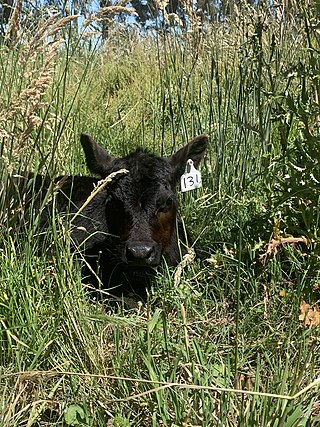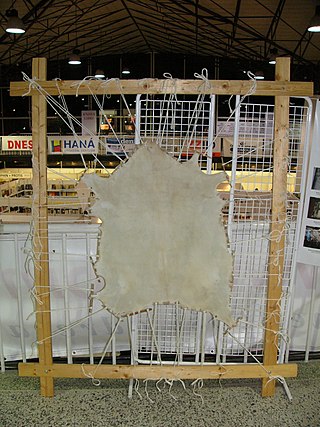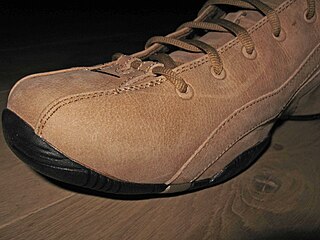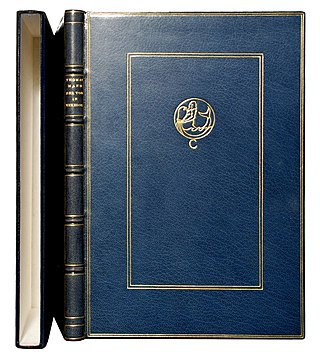
A calf is a young domestic cow or bull. Calves are reared to become adult cattle or are slaughtered for their meat, called veal, and their hide.

Parchment is a writing material made from specially prepared untanned skins of animals—primarily sheep, calves, and goats. It has been used as a writing medium for over two millennia. By AD 400, most literature intended for preservation began to be transferred from papyrus to parchment. Vellum is a finer quality parchment made from the skins of young animals such as lambs and young calves. The generic term animal membrane is sometimes used by libraries and museums that wish to avoid distinguishing between parchment and vellum.

Vellum is prepared animal skin or membrane, typically used as writing material. It is often distinguished from parchment, either by being made from calfskin, or simply by being of a higher quality. Vellum is prepared for writing and printing on single pages, scrolls, and codices (books).

Suede is a type of leather with a fuzzy, napped finish, commonly used for jackets, shoes, fabrics, purses, furniture, and other items.

A Wellington boot, often shortened to welly, and also known as a gumboot, rubber boot, or rain boot, is a type of waterproof boot made of rubber.
A hide or skin is an animal skin treated for human use. The word "hide" is related to the German word Haut, which means skin. The industry defines hides as "skins" of large animals e.g. cow, buffalo; while skins refer to "skins" of smaller animals: goat, sheep, deer, pig, fish, alligator, snake, etc. Common commercial hides include leather from cattle and other livestock animals, buckskin, alligator skin and snake skin. All are used for shoes, clothes, leather bags, belts, or other fashion accessories. Leather is also used in cars, upholstery, interior decorating, horse tack and harnesses. Skins are sometimes still gathered from hunting and processed at a domestic or artisanal level but most leather making is now industrialized and large-scale. Various tannins are used for this purpose. Hides are also used as processed chews for dogs or other pets.

A riding boot is a boot made to be used for horse riding. The classic boot comes high enough up the leg to prevent the leathers of the saddle from pinching the leg of the rider, has a sturdy toe to protect the rider's foot when on the ground and has a distinct heel to prevent the foot from sliding through the stirrup. The sole is smooth or lightly textured to avoid being caught on the tread of the stirrup in the event of a fall.

The davul, dhol, tapan, atabal or tabl is a large double-headed drum that is played with mallets. It has many names depending on the country and region. These drums are commonly used in the music of the Middle East and the Balkans. These drums have both a deep bass sound and a thin treble sound due to their construction and playing style, where different heads and sticks are used to produce different sounds on the same drum.

Chamois leather is a type of porous leather, traditionally the skin of the chamois, a type of European mountain goat, but today made almost exclusively from the flesh split of a sheepskin.

Buckskin is the soft, pliable, porous preserved hide of an animal – usually deer – tanned in the same way as deerskin clothing worn by Native Americans. Some leather sold as "buckskin" may now be sheepskin tanned with modern chromate tanning chemicals and dyed to resemble real buckskin.

The Basel drum is a two-headed rope-tension drum. It takes its name from its origin in Basel. This percussion instrument is best known from the Carnival of Basel, where it is played by more than 2000 drummers. They are called Tambouren in Swiss German or Tambourins in French. There is no typical number of players for marching-bands including this instrument. Anything between three and fifty drummers may be seen in such a formation.

Sheepskin is the hide of a sheep, sometimes also called lambskin. Unlike common leather, sheepskin is tanned with the fleece intact, as in a pelt.

Timila, thimila or paani, (Malayalam:തിമില) is an hour-glass shaped percussion instrument used in Kerala, South India. It is a major percussion instrument used in sree-bali, sree-bhootha-bali and related temple rites. It is made of polished jackwood, and the drumheads made of calfskin are held together by leather braces which are also twined round the waist of the drum. This mechanism helps in adjusting the tension and controlling the sound, mainly two: 'tha' and 'thom'. It is one of the constituting instruments in Panchavadyam.

Nubuck is top-grain leather that has been sanded or buffed on the grain side, or outside, to give a slight nap of short protein fibers, producing a velvet-like surface. It is resistant to wear, and may be white or coloured.

Cowhide is the natural, unbleached skin and hair of a cow. It retains the original coloring of the animal. Cowhides are a product of the food industry from cattle. Cowhide is frequently processed into leather.
Cavalier boots are a style of boot that were popular in Europe between approximately 1500 and 1700. They are soft knee-high leather boots typically made of brown calfskin.

Morocco leather is a vegetable-tanned leather known for its softness, pliability, and ability to take color. It has been widely used in the manufacture of gloves and the uppers of ladies' shoes and men's low cut shoes, but is commonly associated with wallets, linings for fine luggage, and bookbindings.
A slunk is an animal, especially a calf, born prematurely or abortively. Slunk skin, calfskin typically obtained as a byproduct of cattle slaughter, is also known as chickenskin.
Calf most often refers to:

Kidskin or kid leather is a type of soft, thin leather that is traditionally used for gloves. It is widely used for other fashion purposes such as footwear and clothing. Kidskin is traditionally made from goatskin – more specifically, the skin of young goats, although equivalent leathers such as lambskin and chickenskin give the same effect.


















